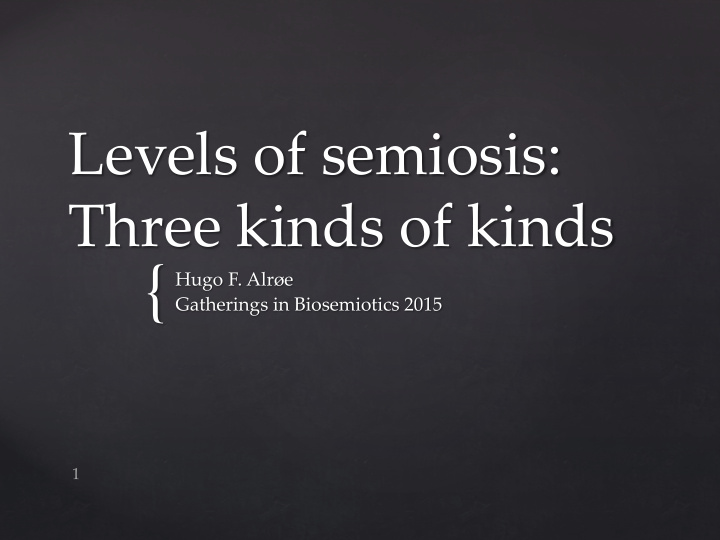



Levels of semiosis: Three kinds of kinds { Hugo F. Alrøe Gatherings in Biosemiotics 2015
Natural kinds and other kinds of kinds Three (semiotic) kinds of kinds Other approaches to semiotic levels Second-order semiosis: Three semiotic levels Substantiation: Evolutionary acelleration Implications for the ‘kinds of kinds’ discussion Conclusion Outline
A long tradition in philosophy for talking about natural kinds Ian Hacking (1986-1995, influential): [ Natural kinds ] Human kinds (looping effects) Ian Hacking (1999): Indifferent kinds | Interactive kinds Kinds of kinds
Critiques R. Cooper (2004): [ Natural kinds [ Human kinds ] ] ( l o o p i n g e f f e c t s ) M.A. Khalidi (2010): Indifferent kinds | Interactive kinds (natural and human) Kinds of kinds - 2
Intuitions Not two, but three kinds of kinds: Indifferent | Adaptive | Reflexive The basis for adaptive and reflexive kinds must be semiotic Reflexive kinds are based on second-order semiosis Semiotic kinds of kinds
Eco semiotic threshold : non-semiotic | semiotic nature | culture Sebeok – life is semiosis (biosemiotics) Deacon – the symbolic species Kull Iconic | Indexical | Symbolic Vegetative | Animal | Cultural Semiotic thresholds
Stjernfelt – the abstract animal symbols in general | hypostatic abstraction animal | man Peirce – the whole universe consists of signs Sebeok -> Nöth Proto-semiosis | Semiosis Non-organic world | Organic world (Life) Semiotic thresholds - 2
( 0) non- or protosemiotic processes without representation • • zeroth-order semiosis • physical or causal processes (1) semiotic processes with representation as the key form of relation • • first-order semiosis • processes of life and cognition (2) second-order semiotic processes with representation of representation • • second-order semiosis • self-conscious and self-reflexive communicative processes Second-order semiosis
Two major evolutionary explosions: Life and human culture = new ontological levels of complexity Secondary explosions: are due to a ‘social’ or ‘systems’ evolution based on the available type of relations A careful prediction: Second-order semiosis is necessary to foster genuine artificial intelligence Evolutionary accelleration
Not two, but three kinds of kinds: Indifferent | Adaptive | Reflexive Non-semiotic | Semiotic | 2 nd order semiotic “Interactive kinds” • confuses the question of levels with the relation between the (scientific) observer and the observed • this is better discussed in terms of systemic sciences ( sciences that influence their subject area) and reflexive objectivity (concerning the influence of the cognitive context) Implications
o There are exactly three basic ontological levels o The levels are semiotic, distinguished by the type of relations found on each level The levels correspond to major evolutionary explosions • Secondary explosions are due to ‘systems’ evolution • based on the available type of relations o The top level is characterised as second-order semiosis – the representation of representations This corresponds to processes of self-consciousness and • self-reflexive communicative systems Conclusions
Levels of semiosis: Three kinds of kinds { Hugo F. Alrøe Gatherings in Biosemiotics 2015 Web: hugo.alroe.dk – with publications for download Email: hugo . f . alroe /at/ gmail . com
Recommend
More recommend